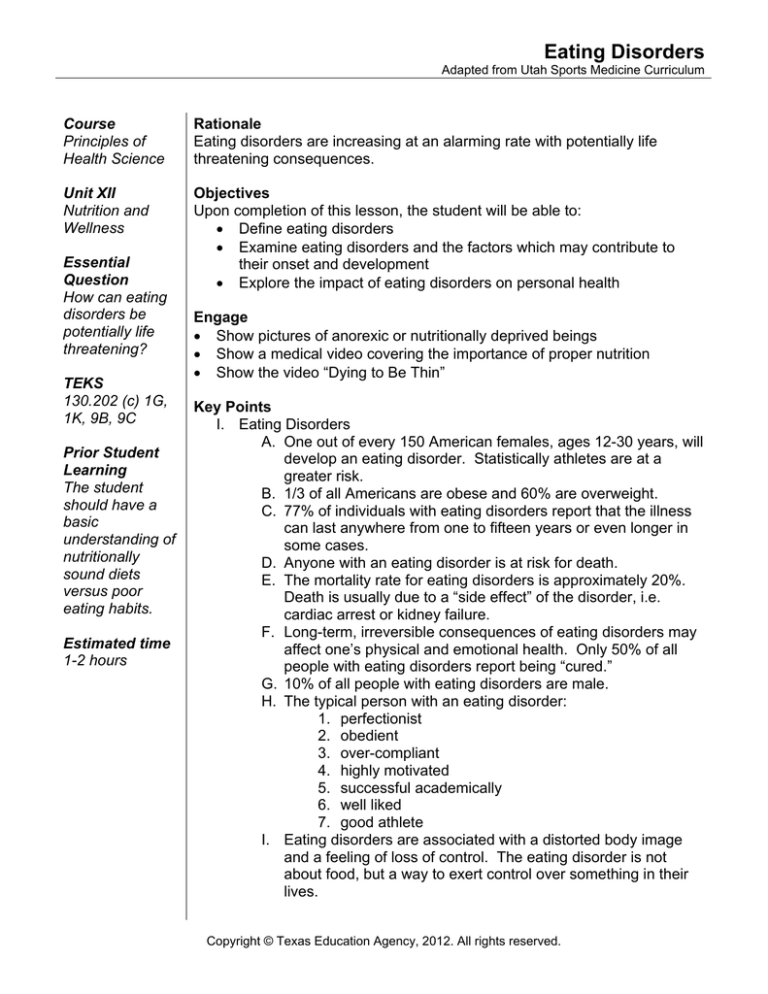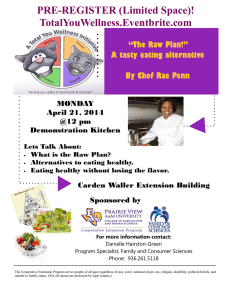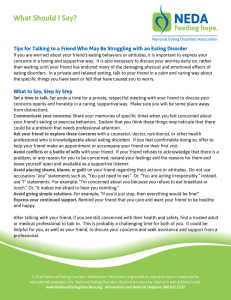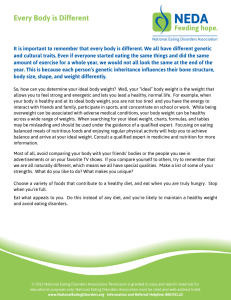Eating Disorders
advertisement

Eating Disorders Adapted from Utah Sports Medicine Curriculum Course Principles of Health Science Rationale Eating disorders are increasing at an alarming rate with potentially life threatening consequences. Unit XII Nutrition and Wellness Objectives Upon completion of this lesson, the student will be able to: Define eating disorders Examine eating disorders and the factors which may contribute to their onset and development Explore the impact of eating disorders on personal health Essential Question How can eating disorders be potentially life threatening? TEKS 130.202 (c) 1G, 1K, 9B, 9C Prior Student Learning The student should have a basic understanding of nutritionally sound diets versus poor eating habits. Estimated time 1-2 hours Engage Show pictures of anorexic or nutritionally deprived beings Show a medical video covering the importance of proper nutrition Show the video “Dying to Be Thin” Key Points I. Eating Disorders A. One out of every 150 American females, ages 12-30 years, will develop an eating disorder. Statistically athletes are at a greater risk. B. 1/3 of all Americans are obese and 60% are overweight. C. 77% of individuals with eating disorders report that the illness can last anywhere from one to fifteen years or even longer in some cases. D. Anyone with an eating disorder is at risk for death. E. The mortality rate for eating disorders is approximately 20%. Death is usually due to a “side effect” of the disorder, i.e. cardiac arrest or kidney failure. F. Long-term, irreversible consequences of eating disorders may affect one’s physical and emotional health. Only 50% of all people with eating disorders report being “cured.” G. 10% of all people with eating disorders are male. H. The typical person with an eating disorder: 1. perfectionist 2. obedient 3. over-compliant 4. highly motivated 5. successful academically 6. well liked 7. good athlete I. Eating disorders are associated with a distorted body image and a feeling of loss of control. The eating disorder is not about food, but a way to exert control over something in their lives. Copyright © Texas Education Agency, 2012. All rights reserved. II. J. Signs to look for include: 1. social isolation 2. lack of confidence in performance 3. ritualistic eating behaviors, such as cutting food into small pieces and playing with it 4. obsession with calories 5. obsession with weight 6. distorted body image 7. wearing layers of baggy clothing to hide thinness 8. nervous at mealtime, avoidance of eating in public 9. pattern of leaving the table directly to go to the bathroom 10. running water in the bathroom after meals to hide the sound of vomiting 11. significant weight loss 12. obsession with grades 13. obsession with organization of personal space 14. high emotions, tearful, up-tight, overly sensitive, restless 15. signs of malnutrition 16. menstrual irregularities 17. loss of hair 18. light-headedness 19. blood-shot eyes 20. inability to concentrate 21. chronic fatigue 22. compulsive exercising 23. decrease in performance 24. recurrent overuse injuries and stress fractures 25. depression Anorexia Nervosa A. The following definition is used by the American Psychiatric Association: 1. Intense fear of gaining weight or becoming fat, even though they are already under-weight. 2. Distorted body image (i.e., claiming to “feel fat” even when emaciated), with an undue influence of body weight or shape on self-perception. 3. Weight loss to less than 85% of normal body weight. 4. Refusal to maintain body weight over a minimal normal weight for age and height. 5. Denial of the seriousness of the current weight loss. 6. Absence of at least three consecutive menstrual cycles. B. Anorexia is a life-threatening condition. Copyright © Texas Education Agency, 2012. All rights reserved. III. IV. V. Bulimia Nervosa A. The definition used by the American Psychiatric Association includes: 1. Recurrent episodes of binge eating, characterized by both of the following: a. eating an unusually large amount of food in a discrete period of time (the amount eaten is larger than most people would eat during a similar time period and under similar circumstances) b. Feeling out of control during the eating episode and unable to stop eating or control what and how much is eaten 2. Purging - compensating for the food binge to prevent weight gain: a. inducing vomiting b. misusing laxatives c. enemas or other medications d. fasting e. exercising excessively. 3. Binge eating and purging, on average, at least twice a week for three months 4. Evaluating self-worth according to body shape and weight B. Many individuals with anorexia will also develop symptoms of bulimia. C. Bulimic behavior can cause: 1. stomach rupture 2. tooth erosion 3. inflammation of the mucous lining of the mouth and throat 4. may eventually cause heart and liver damage Compulsive Eating A. A large percentage of individuals with eating disorders are compulsive eaters. B. A compulsive eater keeps eating beyond the time when hunger has been satisfied. Eating is driven by anxiety, fear, frustration, or anger, rather than by hunger or even pleasure. C. Compulsive eaters do not eat for pleasure. D. Weight does not indicate compulsive eating. Medical Conditions A. Eating disorders are extremely dangerous. 1. in serious cases the body suffers from heart and kidney damage, stomach rupture, urinary infections, and osteoporosis 2. menstrual irregularities and difficulties are also common in women with eating disorders. B. Any victim of an eating disorder must be approached and Copyright © Texas Education Agency, 2012. All rights reserved. handled extremely carefully. Referral for medical treatment is essential! C. Individuals who are truly anorexic or bulimic commonly deny the problem, insisting that they’re perfectly fine. Activity I. Complete the Eating Disorders Questionnaire. Assessment Eating Disorders Quiz Materials Eating Disorders Quiz - KEY http://www.eating-disorder.org/ed.html http://www.nationaleatingdisorders.org Case Studies http://www.yale.edu/ynhti/curriculum/units/1984/5/84.05.05.x.html#f Accommodations for Learning Differences For reinforcement, the student will collect pictures from magazines and newspapers that advertise, glorify or exploit dieting, body image, and/or thinness. For enrichment, the student will complete a case study on a celebrity suffering from an eating disorder. National and State Education Standards National Health Science Cluster Standards HLC06.02 Safety, Health, and Environmental Health care workers will understand the fundamentals of wellness and the prevention of disease processes. They will practice preventive health behaviors among the clients. TEKS 130.202(c) (1)G describe biological and chemical processes that maintain homeostasis; 130.202(c) (1)K identify the concepts of health and wellness throughout the life span. 130.202(c) (9)B identify wellness strategies for the prevention of disease. 130.202(c) (9)C evaluate positive and negative effects of relationships on physical and emotional health such as peers, family, and friends and in promoting a healthy community. Texas College and Career Readiness Standards English Language Arts II. B. Understand new vocabulary and concepts and use them accurately in reading writing and speaking. Copyright © Texas Education Agency, 2012. All rights reserved. EATING DISORDERS QUESTIONNAIRE The following questionnaire will give you an indication of whether or not you are living a lifestyle that indicates anorexic and/or bulimic tendencies. Answer the following questions honestly. Write the number of your answers in the space at the left. ____ 1. I have eating habits that are different from those of my family and friends. 1 – Often 2 – Sometimes 3 – Rarely 4 – Never ____ 2. I find myself panicking if I cannot exercise as I had planned for fear of gaining weight. 1 – Often 2 – Sometimes 3 – Rarely 4 – Never ____ 3. My friends tell me I am thin but I don’t believe them because I feel fat. 1 – Often 2 – Sometimes 3 – Rarely 4 – Never ____ 4. (Females Only) My menstrual period has ceased or become irregular due to no known medical reasons. 1 – True 2 – False ____ 5. I have become obsessed with food to the point that I cannot go through a day without worrying about what I will or will not eat. 1 – Often 2 – Sometimes 3 – Rarely 4 – Never ____ 6. I have lost more than 15 percent of the normal weight for my height (e.g. 30 lbs., from 120 lbs.) 1 – True 2 – False ____ 7. I would panic if I got on the scale tomorrow and found out I had gained two pounds. 1 – Often 2 – Sometimes 3 – Rarely 4 – Never ____ 8. I find that I prefer to eat alone or when I am sure no one will see me, thus I am making excuses so I can eat less and less with friends. 1 – Often 2 – Sometimes 3 – Rarely 4 – Never ____ 9. I find myself going on uncontrollable eating binges during which I consume large amounts of food to the point that I feel sick and make myself vomit. 1 – 3 or more times per day 3 – 1 to 2 times per week 2 – 1 to 2 times per day 4 – Rarely 5 – Never ____ 10. I use laxatives as a means of weight control. 1 – Almost always 2 – Sometimes 3 – Rarely 4 – Never Copyright © Texas Education Agency, 2012. All rights reserved. ____ 11. I find myself playing games with food (e.g. cutting it up into pieces, hiding food so people will think I ate it, chewing it and spitting it out without swallowing) telling myself certain foods are bad. 1 – Often 2 – Sometimes 3 – Rarely 4 – Never ____ 12. People around me have become very interested in what I eat and I find myself getting angry at them for pushing food on me. 1 – Often 2 – Sometimes 3 – Rarely 4 – Never ____ 13. I have felt more depressed and irritable recently than I used to and/or have been spending increasing amounts of time alone. 1 – True 2 – False ____ 14. I keep a lot of my fears about food and eating to myself because I am afraid no one would understand. 1 – Often 2 – Sometimes 3 – Rarely 4 – Never ____ 15. I enjoy making gourmet, high-calorie meals or treats for others as long as I don’t have to eat any myself. 1 – Often 2 – Sometimes 3 – Rarely 4 – Never ____ 16. The most powerful fear in my life is the fear of gaining weight or becoming fat. 1 – Often 2 – Sometimes 3 – Rarely 4 – Never ____ 17. I find myself totally absorbed when reading books about dieting, exercising, and calorie counting to the point that I spend hours studying them. 1 – Often 2 – Sometimes 3 – Rarely 4 – Never ____ 18. I tend to be a perfectionist and am not satisfied with myself unless I do things perfectly. 1 – Almost always 2 – Sometimes 3 – Rarely 4 – Never ____ 19. I go through long periods of time without eating anything (fasting) as a means of weight control. 1 – Often 2 – Sometimes 3 – Rarely 4 – Never ____ 20. It is important to me to try and be thinner than all of my friends. 1 – Almost always 2 – Sometimes 3 – Rarely Add your scores together and compare with the table below: 4 – Never __________ my score Under 30 Strong tendencies toward anorexia nervosa 30 – 45 Strong tendencies toward bulimia 45 – 55 Weight conscious, not necessarily with anorexic or bulimic tendencies Over 55 No need for concern If you scored below 45, it would be wise for you to seek out some kind of help or assistance. Copyright © Texas Education Agency, 2012. All rights reserved. EATING DISORDERS QUIZ 1. List at least 10 signs to look for in someone with an eating disorder: 1. 2. 3. 4. 5. 6. 7. 8. 9. 10. 2. T F At least 10% of all people with eating disorders are male. 3. T F Often, eating disorders are not really about food at all but rather a way for the person to exert control over something in their lives. 4. Describe Anorexia: 5. Describe Bulimia: 6. Describe Compulsive Eating Disorder: 7. T F Eating disorders are extremely dangerous. 8. T F People with eating disorders commonly admit that they have a problem. Copyright © Texas Education Agency, 2012. All rights reserved. EATING DISORDERS QUIZ - KEY 1. List at least 10 signs to look for in someone with an eating disorder: • Social isolation • Ritualistic eating behaviors • Obsessions with weight • Wearing layers of baggy clothing • Go directly to bathroom after eating • Running water to hide vomiting • Obsession with personal organization • Signs of malnutrition • Loss of hair • Blood shot eyes • Chronic fatigue • Decrease in performance • Depression • Lack of confidence • Obsessions with calories • Distorted body image • Avoid eating in public • Significant weight loss • Obsession with grades • High emotions • Menstrual irregularities • Light-headedness • Inability to concentrate • Hyperactivity • Recurrent overuse injuries 2. T F At least 10% of all people with eating disorders are male. 3. T F Often, eating disorders are not really about food at all but rather a way for \ the person to exert control over something in their lives. 4. Describe Anorexia: • Intense fear of gaining weight and becoming fat although they are already underweight; distorted body image; weight loss to less than 85% of normal body weight; refusal to maintain weight; denial of seriousness of the situation; absence of at least three consecutive menstrual cycles. 5. Describe Bulimia: • Recurrent episodes of binge eating and purging by inducing vomiting, misusing laxatives, enemas, or other medications, fasting, or exercising excessively; at least 2 episodes per week for 3 months; evaluating self-worth according to body shape and weight. 6. Describe Compulsive Eating Disorder: • Keeps eating beyond the time when hunger has been satisfied; eating is driven by fear, anxiety, frustration, or anger rather than by hunger or pleasure; may also be a compulsive dieter; it is the relationship to the food that determines whether or not a person is a compulsive eater. 7. T F Eating disorders are extremely dangerous . 8. T F People with eating disorders commonly admit that they have a problem. Copyright © Texas Education Agency, 2012. All rights reserved.





